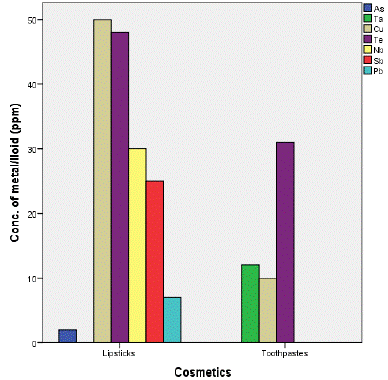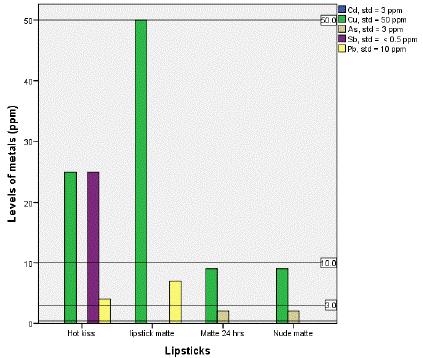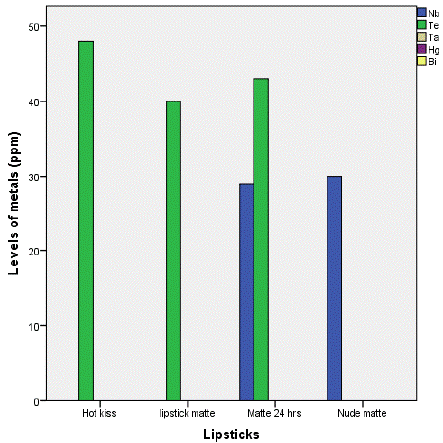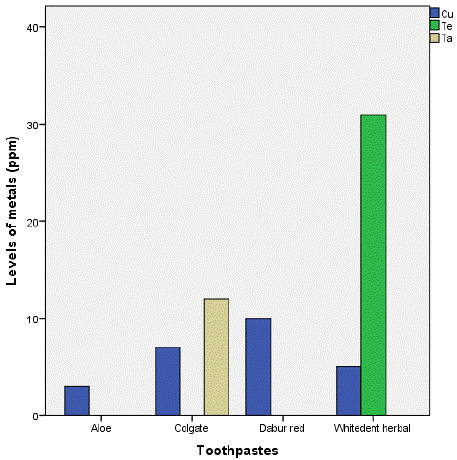
Research Article
Austin Biochem. 2024; 7(1): 1031.
Quantifying the Levels of Niobium, Copper, Arsenic, Tellurium, Antimony and Lead in Selected Toothpaste and Lipsticks Samples
Mwaka S Haji; Miza A Kombo; Abdul AJ Mohamed*
Department of Natural Science, School of Natural and Social Sciences, the State University of Zanzibar. P. O. Box 146, Zanzibar – Tanzania
*Corresponding author: Abdul AJ Mohamed, Department of Natural Science, School of Natural and Social Sciences, the State University of Zanzibar. P. O. Box 146, Zanzibar – Tanzania. Email: jumabdull@yahoo.com
Received: November 06, 2024; Accepted: November 28, 2024; Published: December 05, 2024
Abstract
Cosmetics are essential products for many people worldwide because they help enhance a person’s appearance and boost attractiveness. However, the only challenge in developing countries is the availability of cosmetics that do not meet quality standards, which can pose health risks to users. Upon this study, lipstick samples were found to have high concentration of heavy metals, which are copper (Cu), Arsenic (As), Tellurium (Te), Niobium (Nb), Antimony (Sb), and Lead (Pb) at 50.0 ppm, 2.0 ppm, 48.0 ppm, 30.0 ppm, 25.0 ppm, and 7.0 ppm respectively. With respect to toothpastes, three metals that were found in significant amounts are Cu at 10.0 ppm, Te at 31.0 ppm and Ta at 12.0 ppm. The level of Antimony (Sb) in lipsticks was found to be higher than the limit set by World Health Organization (WHO). This can lead to problems such as skin disease, hormonal disorders, and even cancer. Due to this situation, there is a need to strengthen regulation and monitoring of cosmetic quality in the market, as well as to educate consumers on the importance of choosing safe products for their health. Additionally, cosmetic manufactures should adhere to international standards to protect the health of consumers.
Keywords: Lipsticks; Toothpaste; Tellurium; Antimony; Arsenic; Niobium
Introduction
Lipstick is generally made from a blend of waxes, oils, pigments, and emollients [5]. Typical waxes, such as beeswax, carnauba wax, and candelilla wax, give the lipstick its structure and firmness [38]. Oils like castor oil, lanolin, and mineral oil ensure smoothness and even application [14]. Emollients such as shea butter and vitamin E are included to moisturize and protect the lips [40]. Other pigments, which include a range of natural and synthetic dyes, give lipstick its color. Furthermore, lipsticks and toothpaste are cosmetics intended for application in the oral area, including on the mouth parts, specifically on lips and teeth [15]. Toothpaste typically contains a combination of abrasives, fluoride, flavoring agents, and other ingredients that aid in cleaning, polishing, and freshening breath [34]. Although toothpaste is mainly used for oral hygiene, it also improves the appearance of teeth and contributes to a bright, healthy smile. Lipstick is a popular cosmetic product used to improve the color, texture, and overall look of the lips [17]. It plays a key role in facial aesthetics and carries cultural, psychological, and economic importance. Examples of lipsticks are Matte Lipsticks, Satin and Cream Lipsticks, Gloss Lipsticks, and Liquid Lipsticks [33].
Toothpaste is a gel or paste used in combination with a toothbrush to clean and maintain the health of teeth [26]. Its primary functions are to remove plaque, prevent tooth decay, and reduce gum disease [20]. As toothpaste is used by both adults and children. Reports show that children and some adults (pregnant women especially), swallow a substantial amount of 5 toothpaste in the process of brushing, which could lead to any of the effects associated to the ingestion of these substances [16].
Heavy metals are metallic elements with high atomic weights and densities that are often toxic at relatively low concentrations [2]. They occur naturally in the environment and can also be introduced through industrial processes, agriculture, and pollution [1]. Some heavy metals are essential for biological functions in trace amounts, but excess exposure can lead to serious health problems [21].
The presence of heavy metals in lipsticks and toothpastes is a significant concern due to their potential health risks [9]. Heavy metals found in lipsticks and toothpastes may include lead, cadmium, mercury, and chromium. These metals can be present as contaminants in pigments used for coloring or as impurities in raw materials [23]. Even small amounts of lead can accumulate in the body over time and potentially result in neurological and developmental issues, particularly in children and pregnant women [35]. Exposure to cadmium is associated with kidney damage, bone loss, and cancer [8]. Mercury also can affect the kidneys, nervous system, and immune system, and is particularly harmful when absorbed through the skin or ingested [41].
Zanzibar has emerged as a significant market for cosmetics, with numerous products imported from various countries. The affordability of these cosmetics has led to widespread usage among individuals, particularly those in the middle and lower socioeconomic groups, often without adequate consideration of the product's quality and safety. This research aimed at assessing the levels of toxic metals present in some lipsticks and toothpastes sold in different stores throughout Zanzibar.
As far as public health is concerned tellurium (Te), is ranked higher in toxicity. However, after surveying the previous literature, it has been found that the data reporting the toxicity of these heavy metals are very scarce. As technology advances, demands for the rare such as element Te and other elements are piling up. Because of its extreme toxicity, Te is known to induce both acute and chronic toxicity in different living organisms. For instance, Te exposure is believed to induce neurotoxicity, demyelination, oxidative stress, and neuronal death [22]. Currently, there is no health-related information for such metals like Niobium, Tantalum and Bismuth, thus their existence needs a comprehensive toxicological essay to discover their health impacts.
Toxicity of Selected Metals
Lead (Pb)
The element lead (Pb) has harmful effects to human health, it can enter into the body of organisms via process like inhalation and ingestion, while to a smaller degree it can enter the body through skin absorption [4]. Medical professionals associate the consumption of lead with delayed onset of puberty in girls, menstrual irregularities, and infertility complications. At any level of exposure lead is considered to detrimental [6,13,18]. Moreover, lead is also considered to be latent killing element to living organisms including human [39].
Cadmium (Cd)
Cadmium is one of the most harmful metals. Thus it is not expected to be used or found in the beautification items because it causes serious damage when applied to the body [37]. Cadmium being extremely toxic can cause kidney damage, and bone deformities to mention but a few of its harmful effects even at small level of exposure [29]. Other health impacts associated with consumption of Cd are such as red blood cell damage and hypertension [7. Females who use Cd-containing cosmetics daily risk passing it on to their offspring when pregnant or breastfeeding. Human placenta can accumulate a considerable amount of cadmium damaging steroid hormone synthesis and reproductive system [25]. Current researches have linked Cd to such cancer cases like that of prostate, kidney, pancreas and lung [32].
Mercury (Hg)
Mercury (Hg) is considered as the third-most hazardous metal, is has a tendency of being extremely bio accumulative [10]. It can be absorbed through the skin, and easily can reach the bloodstream even in small extents causing depigmentation inside the nucleus [12]. The unrealistic beauty standards can lead to dangerous consequences. The use of lipsticks containing mercury can endanger the circulatory and urinary systems [30]. The WHO recently warned that the presence and consumption of mercury containing cosmetics are potentially lethal as they can lead to leukaemia, kidney cancer and liver damage [11].
Arsenic (As)
The hazardous element arsenic (As) is typically present in cosmetics, and it has negative effects due to its affinity to skin and keratinizing structures, such as hair and nails [34]. Arsenic can be absorbed through skin ingestion, inhalation, or cosmetic use and has been linked to a variety of health problems, including development, liver enlargement, nervous system damage, skin lesions, respiratory issues, skin cancer and even death [37]. Moreover, arsenic is a protoplastic toxin primarily affecting the sulfhydryl group of cells, causing disruptions in mitosis, cell respiration, and cell enzymes. It also causes malignancy, and hyperkeratosis [36]. The persistent use of arsenic containing cosmetics leads to circulatory complication, neurological damage, and DNA dysfunction. It causes toxicity by blocking the actions of several mitochondrial enzymes, which impairs cellular respiration and oxidative phosphorylation [19].
Methodology
Samples Collection
A total of Eight (8) cosmetics including four (4) lipsticks and four (4) toothpastes purchased at Darajani markets in Zanzibar, all of which were within the expiry dates.
Samples Preparation and Analysis
The samples were prepared under established Standard Operating Procedures (SOPs) and laboratory protocols, adhering strictly to the guidelines outlined in the field sample preparation process. Approximately 5.0 grams of each sample were accurately weighed using a beam balance and placed in sample holders for further analysis. The sample were analyzed using an Energy Dispersive X-Ray Fluorescence (EDXRF) spectrometer (The Rigaku NEX CG model). These fluorescent X-rays are captured in a detector and counted by a multi-channel analyzer. The NEX CG software then calculates the concentration of each element present in the sample.
Data Analysis
The data analysis focuses at assessing the levels of some heavy metals in selected cosmetics. These selected cosmetics consisted of four (4) lipsticks and four (4) toothpastes. The parameters involved in the descriptive analysis of the data are mean, standard deviation, minimum, and maximum values of the metals (Table 1 & Table 2). During sample analysis, seven (07) metals Cu, Cd, Nb, Ta, Hg, Pb, and Bi, and three (3) metalloids (arsenic (As), antimony (Sb), and tellurium (Te), their levels were assessed in unit of ppm for each sample.
Elements
Minimum (ppm)
Maximum (ppm)
Mean (ppm)
Std. Deviation (ppm)
Cu
9
50
23.25
19.363
As
BDL
2
1.00
1.155
Cd
BDL
BDL
NA
NA
Nb
BDL
30
14.75
17.037
Sb
BDL
25
6.25
12.500
Ta
BDL
BDL
NA
NA
Hg
BDL
BDL
NA
NA
Pb
BDL
7
2.75
3.403
Bi
BDL
BDL
NA
NA
Te
BDL
48
32.75
22.081
Table 1: Descriptive Statistics of Metals in Lipsticks.
Elements
Minimum (ppm)
Maximum (ppm)
Mean (ppm)
Std. Deviation (ppm)
Cu
3
10
6.25
2.986
As
BDL
BDL
NA
NA
Nb
BDL
BDL
NA
NA
Cd
BDL
BDL
NA
NA
Sb
BDL
BDL
NA
NA
Te
BDL
31
7.75
15.500
Ta
BDL
12
3.00
6.000
Hg
BDL
BDL
NA
NA
Pb
BDL
BDL
NA
NA
Bi
BDL
BDL
NA
NA
Table 2: Descriptive Statistics on Metals in Toothpastes.
General Data Analysis of Metals in Lipsticks and Toothpastes
Lipsticks and Toothpastes were tested for the presence of heavy metals, and the results showed that lipsticks contain a higher level of heavy metals compared to toothpastes. Six metals (As, Cu, Nb, Pb, Sb, and Te) were found in lipsticks accounting for 70 % of all the metals analyzed, while only three metals (Cu, Ta, and Te) were detected in toothpastes which is equivalent to 30 % (Table 3 & Figure 1).
Cosmetics
Trend of Metals
Metals Below Detection Limit
Lipsticks
Cu > Te > Nb > Sb > Pb > As
Cd, Ta, Hg, and Bi
Toothpastes
Te > Ta > Cu
As, Nb, Cd, Sb, Hg, Pb, and Bi
Table 3: Occurrence of Metals in Lipsticks and Toothpastes.

Figure 1: chromatogram of sample solution (80 μg/mL).
Data Analysis on As, Cu, Cd, Sb, and Pb in Lipsticks
The lipsticks which were included in this study are (Nude matte, Matte 24 Hours, Hot kiss and Lipsticks matte) all imported from China. Antimony (Sb) and Arsenic (As) as metalloids and heavy metals Cu, and Pb were detected in all lipstick’s samples, while Cd was not detected (below the detection limit). Cu, Sb, As, and Pb levels were 50.0 ppm, 25.0 ppm, 2.0 ppm, and 7.0 ppm respectively (Figure 2). The Antimony level exceeds the maximum amount suggested by WHO and USFDA, which is (<0.5 ppm). The levels of these metals, were in the following trend: Cu > Sb > Pb > As.

Figure 2: levels of As, Cu, Cd, Sb, and Pb.
Data Analysis on Bi, Hg, Nb, Ta, and Te in Lipsticks
Another metals detected in lipstick samples were Nb, and Te, at 30.0 ppm and 48.0 ppm respectively. Bi, Hg, and Ta were below detection limits (Figure 3).

Figure 3: Levels of Bi, Hg, Nb, Ta, and Te.
Data Analysis of Metals in Toothpaste Samples
In toothpaste samples, seven (07) metals which are: Cu, Cd, Nb, Ta, Hg, Pb, and Bi, and three (3) metalloids (arsenic (As), antimony (Sb), and tellurium (Te), their levels were assessed in each sample in unit of ppm. But in toothpaste samples only one (1) metalloid (Te), and two (2) metals (Ta and Cu) were detected. Cd, As, Sb, Nb, Hg, Bi, and Pb were below detection limit.
Assessment of Cu, Ta and Te.
The traces of Cu, Ta, and Te were detected in toothpaste samples at levels of 10.0 ppm, 12.0 ppm, and 31.0 ppm respectively (Figure 4).

Figure 4: Levels of Cu, Ta and Te.
References
- Abdullahi A, Lawal MA, Salisu AM. Heavy metals in contaminated soil: source, accumulation, health risk and remediation process. Bayero Journal of Pure and Applied Sciences. 2021; 14: 1-12.
- Ali H, Khan E. What are heavy metals? Long-standing controversy over the scientific use of the term ‘heavy metals’–proposal of a comprehensive definition. Toxicological & Environmental Chemistry. 2018; 100: 6-19.
- Al-Saleh IA. Health implications of mercury exposure in children. International Journal of Environment and Health. 2009; 3: 22-57.
- Al Osman M, Yang F, Massey IY. Exposure routes and health effects of heavy metals on children. Biometals. 2019; 32: 563-573.
- Anilkumar V, Dhanaraju MD. A Review on Herbal lipsticks. Journal of Pharmaceutical Advanced Research. 2021; 4: 1179-1182.
- Ayenimo JG, Yusuf AM, Adekunle AS, Makinde OW. Heavy metal exposure from personal care products. Bulletin of environmental contamination and toxicology. 2010; 84: 8-14.
- Balali-Mood M, Naseri K, Tahergorabi Z, Khazdair MR, Sadeghi M. Toxic mechanisms of five heavy metals: mercury, lead, chromium, cadmium, and arsenic. Frontiers in pharmacology. 2021; 12: 643972.
- Bernard A. Cadmium & its adverse effects on human health. Indian journal of medical research. 2008; 128: 557-564.
- Borowska S, Brzóska MM. Metals in cosmetics: implications for human health. Journal of applied toxicology. 2015; 35: 551-572.
- Broussard LA, Hammett-Stabler CA, Winecker RE, Ropero-Miller JD. The toxicology of mercury. Laboratory medicine. 2002; 33: 614-625.
- Burger P, Landreau A, Azoulay S, Michel T, Fernandez X. Skin whitening cosmetics: Feedback and challenges in the development of natural skin lighteners. Cosmetics. 2016; 3: 36.
- Burnase N, Jaiswal S, Barapatre A. Metal Toxicity in Humans Associated with their Occupational Exposures Due to Mining. In Medical Geology in Mining: Health Hazards Due to Metal Toxicity. 2022: 127-186.
- Chauhan AS, Bhadauria R, Singh AK, Lodhi SS, Chaturvedi DK, Tomari VS. Determination of lead and cadmium in cosmetics products. Journal of Chemical and Pharmaceutical Research. 2010; 2: 92–97.
- Coupland K, Nichols JA. Lipids: their use in personal care products. In Lipid Technologies and Applications. Routledge. 2018: 695-709.
- Dhawan S, Sharma P, Nanda S. Cosmetic nanoformulations and their intended use. In Nanocosmetics. Elsevier. 2020: 141-169.
- Hernandez MC, Lopez IG, Sanchez-Pedrena C. Spectrophotometric determination of saccharin in different materials by a solvent extraction method Holistic using Nile blue as reagent. Talanta. 1985; 32: 325-327.
- Heusèle C, Cantin H, Bonté F. Lips and lipsticks. Cosmetic dermatology: products and procedures. 2022: 252-258.
- Horowitz Y, Greenberg D, Ling G, Lifshitz M. Acrodynia: A case report of two siblings. Archives of Disease in Childhood. 2002; 86: 453.
- Hosseini MJ, Shaki F, Ghazi-Khansari M, Pourahmad J. Toxicity of arsenic (III) on isolated liver mitochondria: a new mechanistic approach. Iranian journal of pharmaceutical research: IJPR. 2013; 12: 121-38.
- Iqbal K, Asmat M, Jawed S, Mushtaque A, Mohsin F, Hanif S, et al. Role of different ingredients of tooth pastes and mouthwashes in oral health. Jpda. 2011; 20: 163-170.
- Jaishankar M, Tseten T, Anbalagan N, Mathew BB, Beeregowda, KN. Toxicity, mechanism and health effects of some heavy metals. Interdisciplinary toxicology. 2014; 7: 60-72.
- Kanafchian M, Esmaeilzadeh S, Mahjoub S, Rahsepar M, Ghasemi M. Status of Serum Copper, Magnesium, and Total Antioxidant Capacity in Patients with Polycystic Ovary Syndrome. Biol. Trace Elem. Res. 2020; 193: 111–117.
- Karimi G, Ziarati P. Heavy metal contamination of popular nail polishes in Iran. Iranian Journal of Toxicology. 2015; 9: 1290-1295.
- Khuwaja G, Al-Bratty M, Alhazmi HA, Khan A, Safhi MM, Ashafaq M, et al. Pharmacological melioration by selenium on the toxicity of tellurium in neuroendocrine centre (pituitary gland) in male wistar rats: A mechanistic approach. Saudi Pharm J. 2020; 28: 630–636.
- Kumar S, Sharma A. Cadmium toxicity: effects on human reproduction and fertility. Reviews on environmental health. 2019; 34: 327-338.
- Lippert F. An introduction to toothpaste-its purpose, history and ingredients. In Toothpastes. Karger Publishers. 2013; 23: 1-14.
- Liu J, Li N, Zhang W, Wei X, Tsang DCW, Sun Y, et al. Thallium contamination in farmlands and common vegetables in a pyrite mining city and potential health risks. Environ Pollut. 2019; 248: 906–915.
- Liu J, Luo X, Wang J, Xiao T, Chen D, Sheng G, et al. Thallium contamination in arable soils and vegetables around a steel plant-A newly-found significant source of Tl pollution in South China. Environ Pollut. 2017; 224: 445–453.
- Odukudu FB, Ayenimo JG, Adekunle AS, Yusuff AM, Mamba BB. Safety evaluation of heavy metals exposure from consumer products. Int J Consum Stud. 2014; 38: 25-34.
- Naqvi SAR, Idrees F, Sherazi TA, Hassan SU, Ishfaq N. Toxicology of heavy metals used in cosmetics. J Chil Chem Soc. 2022; 67: 5615.
- New Zealand Dental Association. Healthy smile, healthy child: Oral health guide for well child providers. Auckland: New Zealand Dental Association. 2008.
- Rehman K, Fatima F, Waheed I, Akash MSH. Prevalence of exposure of heavy metals and their impacts on health consequences. J Cell Biochem. 2018; 119: 157-184.
- Richard C. Lipstick adhesion measurement. Surface Science and Adhesion in Cosmetics. 2021: 635-662.
- Roberts E, Mason S. Oral Care–A Mouthful of Chemistry. Salama AK. Assessment of metals in cosmetics commonly used in Saudi Arabia. Environmental monitoring and assessment. 2016; 188: 553.
- Sanders T, Liu Y, Buchner V, Tchounwou PB. Neurotoxic effects and biomarkers of lead exposure: a review. Reviews on environmental health. 2009; 24: 15-46.
- Schierbeck J, Vestergaard T, Bygum A. Skin cancer associated genodermatoses: a literature review. Acta dermato-venereologica. 2019; 99: 360-369.
- Shikha K, Gangasagre N. Toxic Effect of Heavy Metals in Cosmetic Products and Health Concern. Int J Ayurvedic Herb Med. 2018; 8: 3196-3201.
- Shimizu MS, Nomura Y, Bui HS. Effect of cosmetic oils on lipstick structure and its deposit. Surface Science and Adhesion in Cosmetics. 2021: 35-71.
- Sprinkle RV. Leaded eye cosmetics: a cultural cause of elevated lead levels in children. Journal of Family Practice. 1995; 40: 358-362.
- Veludurthi PA, Vadaga AK. A Comprehensive Review of Formulations, Ingredients, Advances, and Future Perspectives in Lipcare Cosmetics. Journal of Pharma Insights and Research. 2024; 2: 123-128.
- Zulaikhah ST, Wahyuwibowo J, Pratama AA. Mercury and its effect on human health: A review of the literature. International Journal of Public Health Science. 2020; 9: 103-114.